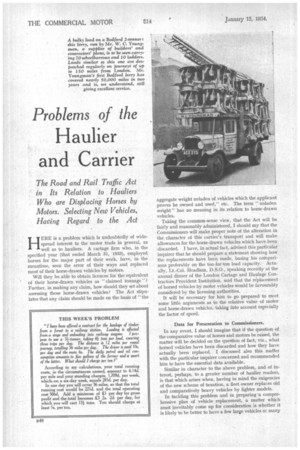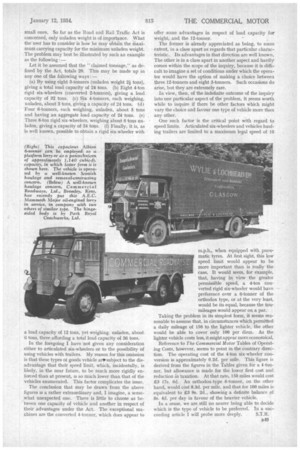Problems of the
Page 66

Page 67

If you've noticed an error in this article please click here to report it so we can fix it.
Haulier and Carrier
The Road and Rail Traffic Act in Its Relation to Hauliers Who are Displacing Horses by Motors. Selecting New Vehicles, Having Regard to the Act
I ERE is a problem which is undoubtedly of wide
spread interest to the motor trade in general, as well as to hauliers. A cartage firm who, in the specified year (that ended March 31, 1933), employed horses for the major part of their work, have, in the meantime, seen the error of their ways and replaced most of their horse-drawn vehicles by motors. Will they be able to obtain licences for the equivalent of their horse-drawn vehicles as "claimed tonnage " ? Further, in making any claim, how should they set about assessing those horse-drawn vehicles? The Act stipulates that any claim should be made on the basis of "the aggregate weight unladen of vehicles which the applicant proves he owned and used," etc. The term "unladen weight" has no meaning in its relation to horse-drawn vehicles. Taking the common-sense view, that the Act will be fairly and reasonably administered, I should say that the Commissioners will make proper note of the alteration in the character of this carrier's transport and will make allowances for the horse-drawn vehicles which have been discarded. I have, in actual fact, advised this particular inquirer that he should prepare a statement showing how the replacements have been made, basing his comparisons preferably on the ton-for-ton load capacity. Actually, LE.-Col. Headlam, D.S.O., speaking recently at the annual dinner of the London Cartage and Haulage Contractors Provident Institution, said that the replacement of horsed vehicles by motor vehicles would be favourably consideied by the licensing authorities. , • It will be necessary for him to go prepared to meet some little argiiments as to the relative value of motor and horse-drawn vehicles, taking into account especially the factor of speed.
Data for Presentation to Commissioners.
In any event, I should imagine that if the question of the comparative value of horses and motors be raised, the matter will be decided on the question of fact, viz., what horsed vehicles have been discarded and how they have actually been replaced. I 'discussed also this matter with the particular inquirer concerned and recommended him to have the essential data available. Similar in character to the above problem, and of interest, perhaps, to a greater number of haulier readers, is that which arises when, having in mind the exigencies of the new scheme of taxation, a fleet owner replaces old and comparatively heavy vehicles by lighter models. In tackling this problem and in preparing 'a comprehensive plan of vehicle replacement, a matter which must inevitably come up for consideration is whether it is likely to be better to have a few large vehicles or many
small ones. So far as the Road and Rail Traffic Act is concerned, only unladen weight is of importance. What the user has to consider is how he may obtain the maximum carrying capacity for the minimum unladen weight. The problem may best be illustrated by such an exam& as the following :— Let it be assumed that the "claimed tonnage," as defined by the Act, totals 20. This may be made up in any one of the following ways : — (a) By using eight 3-tonners (unladen weight 2k tons), giving a total load capacity of 24 tons, (b) Eight 9-ton rigid six-wheelers (converted 2-tonners), giving a load. capacity of 32 tons. (c) Six 4-tonners, each weighing, unladen, about 3 tons, giving a capacity of 24 tons. (d) Four 6-tonners, each weighing, unladen, about 5 tons and having an aggregate load capacity of 24 tons. (e) Three 8-ton rigid six-wheelers, weighing about 6 tons unladen, giving a capacity of 24 tons. (f) Finally, it is, as is well known, possible to obtain a rigid hix-wheeler with a load capacity of 12 tons, yet weighing, unladen, about 6 tons, three affording a total load capacity of 36 tons.
In the foregoing I have not given any consideration either to articulated six-wheelers or to the possibility of using vehicles with trailers. My reason for this omission is that these types of goods vehicle aittsubject to the disadvantage that their speed limit, which, incidentally, is likely, in the near future, to be much more rigidly enforced than at present, is so much lower than that of the vehicles enumerated. This factor complicates the issue.
The conclusion that may be drawn from the above figures is a rather extraordinary and, I imagine, a somewhat unexpected one. There is little to choose as between one capacity of vehicle and another in respect of their advantages under the Act. The exceptional machines are the converted 4-ton ner, which does appear to
offer some advantages in respect of load capacity for weight, and the 12-tonner.
The former is already appreciated as being, to some extent, in a class apart as regards that particular characteristic. Its advantages in that direction are well known. The other is in a class apart in another aspect and hardly comes within the scope of the inquiry, because it is difficult to imagine a set of conditions under which the operator would have the option of making a choice between three 12-tonners and eight 3-tonners. Such occasions do arise, but they are extremely rare.
In view, then, of the indefinite outcome of the inquiry into one particular aspect of the problem, it seems worth while to inquire if there be other factors which might vary the choice and favour one type of vehicle more than any other.
One such factor is the critical point with regard to speed limits. Articulated six-wheelers and vehicles haul-. ing trailers are limited to a maximum legal speed of 16
m.p.h., when equipped with pneumatic tyres. At first sight, this low speed limit would appear to be more important than is really the case. It would seem, for example, that, having in view the greater permissible speed, a 4-ton converted rigid six-wheeler would have preference over a 6-tanner of the orthodox type, or at the very least, would be its equal, because the tonmileages would appear on a par.
Taking the problem in its simplest form, it seems reasonable to assume that, in circumstances Which permitted a daily mileage of 150 to the lighter vehicle, the other would be able to cover only 100 per diem. As the lighter vehicle costs less, it might appear more economical
Reference to The Commercial Motor Tables of Operating Costs, however, seems to point in the Contrary direction. The operating cost of the 4-ton six-wheeler conversion is approximately 6.2d. per mile. This figure is derived from the figures in the Tables given for a 4-tonner, but allowance is Made for the lower first cost and reduction in taxation. At that rate, 150 miles would cost £3 17s. 6d. 'An orthodox-type 6-tonner, on the other hand, would cast 8.3d. per mile, and that for 100 miles is equivalent to £3 9s. 2d., showing a definite balance of 8s. 4d. per day in favour of the heavier vehicle.
In a sense, we are still no nearer being able to decide which is the type of vehicle to be preferred. In a suc ceeding article I will probe more deeply. S.T.R.




































































































